

Audio By Carbonatix
[
{
"name": "GPT - Leaderboard - Inline - Content",
"component": "35519556",
"insertPoint": "5th",
"startingPoint": "3",
"requiredCountToDisplay": "3",
"maxInsertions": 100,
"adList": [
{
"adPreset": "LeaderboardInline"
}
]
}
]
Page 2 of 3
The tri-cities of cancer
The next afternoon, we barrel down Interstate 75 into an industrial hellscape of smoke stacks, flare offs, and 18-wheelers, en route to another toxicity and accountability crisis. This one was caused by a massive tar sands refinery and dozens of other industrial polluters in southwest Detroit and neighboring River Rouge and Ecorse, cities lying along the banks of the Detroit River.
Already with a slight headache from a haze of emissions, we meet photographer and community leader Emma Lockridge and her neighbor Anthony Parker in front of their homes, which sit right in the backyard of that tar sands refinery.
In 2006, the toxicity levels in their neighborhood, known simply by its ZIP code as "48217," were 45 times higher than the state average. And that was before Detroit gave $175 million in tax breaks to the billion-dollar Marathon Petroleum Corp. to help it expand its refinery complex to process a surge of high-sulfur tar sands from Alberta.
"We're a donor zip," says Lockridge as she settles into the driver's seat of our car. "We have all the industry and a tax base, but we get nothing back."
We set off on a whirlwind tour of their neighborhood, where schools have been torn down and parks closed due to the toxicity of the soil, while so many residents have died of cancer that it's hard for their neighbors to keep track. "We used to play on the swings here," says Lockridge, pointing to a rusted yellow swing set in a fenced-off lot where the soil has tested for high levels of lead, arsenic, and other poisonous chemicals. "Jumping right into the lead."
As in other regions of Michigan, people have been fleeing 48217 in droves. Here, however, the depopulation results not from deindustrialization, but from toxicity, thanks to an ever-expanding set of factories. These include a wastewater treatment complex, salt mines, asphalt factories, cement plants, a lime and stone foundry, and a handful of steel mills all clustered in the tri-cities region.
As Lockridge and Parker explain, they have demanded that Marathon buy their homes. They have also implored the state to cap emission levels and have filed lawsuits against particularly toxic factories. In response, all they've seen are more factories given more breaks, while the residents of 48217 get none. Last spring, for example, the Michigan Department of Environmental Quality permitted the AK Steel plant, located close to the neighborhood, to increase its toxic emissions as much as 725 times. The approval, according to the Detroit Free Press, came after "Gov. Rick Snyder's business-promoting agency worked for months behind the scenes" lobbying the Department of Environmental Quality.
"Look at this cute little tree out of nowhere over here!" Lockridge exclaims, slowing the car in front of a scrawny plant whose branches, in the midst of this industrial wasteland, bend under the weight of white blossoms.
"That tree ain't gonna grow up," Parker responds. "It's dead already."
"It's trying," Lockridge insists. "Aww, it's kind of sad. It's a Charlie Brown tree."
The absurdity of life in such an environment is highlighted when we reach a half-mile stretch of sidewalk sandwiched between a massive steel mill and a coal-fired power plant that has been designated a "Wellness Walk."
"Energize your life!" implores the sign affixed to a chain-link fence surrounding the power plant. It's an unlikely site for an exercise walk, given that the state's health officials consider this strip and the nearby park "the epicenter of the state's asthma burden."
After a sad laugh, we head for Zug Island, a Homeland Security-patrolled area populated by what look to be giant black vacuum cleaners but are actually blast furnaces. The island was named for millionaire Samuel Zug, who built a lavish mansion there only to discover it was sinking into swampland. It is now home to U.S. Steel, the largest steel manufacturer in the nation.
On our way back, we make a final stop at Oakwood Heights, an almost entirely vacant and partially razed subdivision located on the other side of the Marathon plant. "This is the white area that was bought out," says Lockridge. The scene is eerie: small residential streets lined by grassy fields and the occasional empty house. That Marathon paid residents to evacuate their homes in this predominantly white section of town, while refusing to do the same in the predominantly African-American 48217, which sits closer to the refinery, strikes neither Lockridge and Parker nor their neighbors as a coincidence.
We survey the remnants of the former neighborhood: bundles of ragged newspapers someone was once supposed to deliver, a stuffed teddy bear abandoned on a wooden porch, and a childless triangle-shaped playground whose construction, a sign reads, was "made possible by generous donations from Marathon."
As this particularly unmagical stop on our Michigan tour comes to an end, Parker says quietly, "I've got to get my family out of here."
Lockridge agrees. "I just wish we had a refuge place we could go to while we're fighting," she says. "You see we're surrounded."
The great white north
Not all of Michigan's problems are caused by emergency management, but this sweeping new power does lie at the heart of many local controversies. Later that night we meet with retired Detroit city worker, journalist, and organizer Russ Bellant, who has made himself something of an expert on the subject.
In 2011, he says, Snyder signed an emergency manager law known as Public Act 4. The impact of this law and its predecessor, Public Act 72, was dramatic. In the city of Pontiac, for instance, the number of public employees plummeted from 600 to 50. In Detroit, the emergency manager of the school district waged a six-year slash-and-burn campaign that, in the end, shuttered 95 schools. In Benton Harbor, the manager effectively dissolved the city government, declaring: "The fact of the matter is, the city manager is now gone. I am the city manager. I replace the financial director, so I'm the financial director and the city manager. I am the mayor and the commission. And I don't need them."
So in 2012, Bellant canceled all his commitments in Detroit, packed his car full of chocolate pudding snacks, canned juices, and fliers and headed north to support a statewide campaign to repeal the law through a ballot referendum in that fall's general election. For two months, he crisscrossed the upper reaches of the Lower Peninsula, as well as the remote Upper Peninsula that borders Wisconsin and Canada.
"Seven or eight hours a day, I would just knock on doors," he says.
In November, the efforts paid off and voters repealed the act, but the celebration was short-lived. Less than two months later, during a lame-duck session of the state legislature, Snyder pushed through and signed Public Act 436, a broader version of the legislation that was referendum-proof. Since then, financial managers have continued to shut down fire departments, outsource police departments, sell off parking meters and public parks. In Flint, the manager even auctioned off the plastic Santa Claus that once adorned city hall, setting the initial bidding price at $5.
And here's one fact of life in Michigan: Emergency management is normally only imposed on majority-black cities. From 2013 to 2014, 52 percent of the African-American residents in the state lived under emergency management, compared to only 2 percent of white residents. And yet the repeal vote against the previous version of the act was a demographic landslide: 75 out of 83 counties voted to nix the legislation, including all of Michigan's northern, overwhelmingly white, rural counties. "I think people just internalized that P.A. 4 was undemocratic," Bellant says.
That next morning, we travel north to the city of Alpena, a 97 percent white lakeside town where Bellant knocked on doors and the recall was triumphant. The farther north we head, the more the landscape changes. We pass signs imploring residents to "Take back America: Liberty yes, tyranny no." Gas stations feature clay figurines of hillbillies drinking moonshine in bathtubs.
It's almost evening when we arrive. We spend part of our visit at the Dry Dock, a dive bar overseen by a raspy-voiced bartender where all the political and demographic divides of the state — and, in many ways, the country — are on full display. Two masons are arguing about their union; the younger one likes the protections it provides, while his colleague ditched the local because he didn't want to pay the dues. That move became possible only after Snyder signed controversial "right to work" legislation in 2012, allowing workers to opt out of union dues and causing a sharp decline in union membership ever since.
Above their heads, the television screen projects intentionally terrifying images of the uprising in Baltimore in response to the police murder of Freddie Gray, an unarmed African-American man. "The Bloods, the Crips, and the Guerrillas are out for the National Guard," comments a carpenter about the unarmed protesters, a sneer of distain in his voice. "Not that I like the fucking cops, either," he adds.
Throughout our visit, people repeatedly told us Alpena "isn't Detroit or Flint" and that they have absolutely no fear of the state seizing control of their sleepy, white, touristy city. When we press the question with the owner of a bicycle shop, the hostility rises in his voice as he explains: "Things just run the way they should here" — by which he means, of course, that down in Detroit and Flint, residents don't run things the way they should.
Yet, misconceptions notwithstanding, the county voted to repeal Public Act 4 with a staggering 63 percent of those who turned out opting to strike down the law.
Reflecting Bellant's feeling that locals grasped the law's undemocratic nature in some basic way, even if it would never affect them personally, one resident offered this explanation: "When you think about living in a democracy, then this is like financial martial law ... I know they say these cities need help, but it didn't feel like something that would help."





